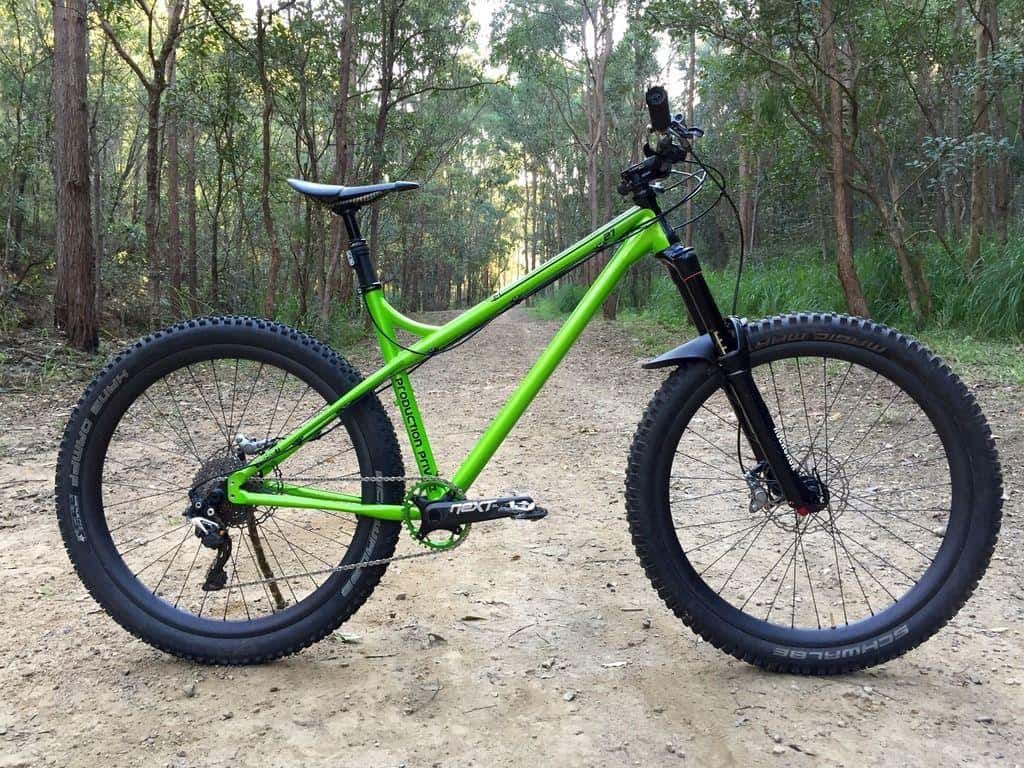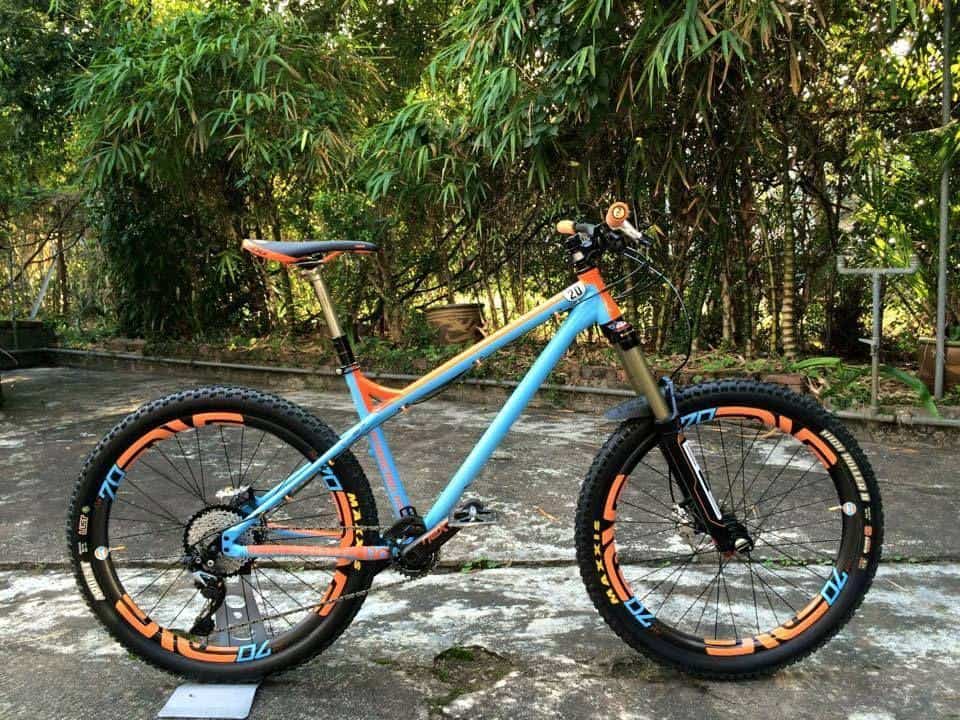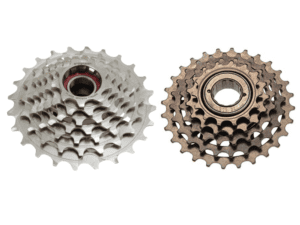When you’re new to mountain biking there are a lot of terms that might be confusing. One of those hat you will run into quite early is the word hardtail. What is a hardtail? In this article I will explain exactly what it is and, how it differs from other types of Mountain bikes and who it’s for.
What Are Hardtail Mountain Bikes Good For?

A bike frame built with a rigid or semi-rigid fork and a rear shock, usually with a single pivot. The term “hardtail” originates from the lack of rear suspension. Contrary to other bikes, they use a rigid fork instead of a suspension to cushion the trail vibrations to make your ride smoother and easier.
Hardtail is also known as a rigid mountain bike, hardtail MTB, XC, and rigid mountain bike.
Compared to other types of a mountain bike, hardtails are better because:
1.Hardtails offer a smooth ride for first-time riders as compared to suspension mountain bikes.
Hence, they’re better for beginners since they won’t make the trail too rough. It doesn’t have a pedal bob that usually features a fluid rear end. So, no power and effort will be lost for every movement of the rear shock.
2. Hardtail will also teach you to adjust your body to make sure your legs are strong enough. This is to combat the increased vibration coming from the rear end of your bike. With the lack of rear suspension and narrow tires demand precision, it’s a great option for winter training.
3. It’s more affordable than a full-suspension bike. In fact, some of them can be just below $500 even if they are made for every kind of terrain.
4. Bike geometry and wheel size also allow hardtail to have faster acceleration than other types of mountain bikes. Because of this, riding a hardtail is definitely fun as you can enjoy the speed without sacrificing comfort.
5. In addition to these things, a hardtail can also help you get that downhill riding experience especially when it comes to dirt jumping.
6. Hardtail can be suitable for both XC and freeride. Whether you want to speed through a rocky uphill or go on a muddy downhill, a hardtail will have the right equipment to keep you safe and sound.
What Are The Types of Hardtail Bike?
There are various types of hardtail mountain bikes, and the number one thing you need to consider is your riding style. Other than that, take into account the type of suspension you want to experience.
The 4 main hardtail types are cross-country, enduro, all-mountain, and downhill. They have different features from the frame geometry to their specifications.
1. XC Bikes
Also known as cross country, XC hardtails are specifically engineered for fast and endurance riding. More often than not, they often feature 75-100mm front suspension, high gear range, a steep head tube, and narrow bars and tires.
These specifications are intended for long-ride shenanigans that demand shift for a position in the saddle. It further allows movement when going downhill and uphill.
2. Trail MTBs
Best for rough roads and forest paths that trigger adrenaline rush, trail bikes can give you an unforgettable adventure.
They are designed with shorter terms, relaxed angles, wider gear range, and 100 to 150mm front suspension.
Also, they provide enough suspension to make descending better without sacrificing your bike’s climbing ability.
3. Electric Hardtail MTBs
Electric hardtails are something between a cross-country and trail model. They offer the features of both but are still sensitive to terrain flexing.
In fact, they’re still stiffer than normal Hardtails because of the steep geometry and aluminum rear triangle.
With an integrated motor that is powered by a lithium-ion battery, these bikes allow for extended range per charge and better hill climbing abilities as well as charges on the go without a cell phone or power outlet.
4. Enduro

Enduro bikes are specifically made for downhill racing and extreme mountain bike performance. They have 170 to 180mm of travel, geared towards the gravity rider.
Key features that define enduro bikes are the shorter chainstays (narrower rear triangle) and slack head tube angle.
This results in better stability when bombing down steeper terrain as it obtains extra traction, efficiency, stability, and cranks power.
Frames for Hardtail Bikes
Hardtails are mostly constructed of aluminum but there are also carbon-framed models. The majority of hardtail frames are aluminum because it’s lighter and stronger than steel products.
However, some carbon-framed bikes have increased rigidity due to their added weight and sturdiness. There is a good variety of material to choose from:
Aluminum, alloy, titanium (Ti), and composite frame materials.
Aluminum frames are constructed from a mixture of materials that include aluminum to provide the strength and stiffness needed, while carbon fiber is added to provide additional rigidity.
The material also adds to the bike’s weight, which is a common problem with aluminum hardtails. Alloy frames are made of both steel and aluminum materials for their durability and low weight-to-cost ratio. These models can be heavy at times but still, work well in most situations.
Which is better: Hardtail or Full Suspension MTBs?
There’s no such thing as “better” in this situation. It all boils down to your intended trail biking, and how you want to experience it.
Sadly, you will never find an answer to this question because everyone has their own preferences and needs. Full-suspension mountain bikes are praised for their ability to remove the jarring of rough trails and thus improve performance.
On the other hand, hardtails are for people who can appreciate a more refined skill that comes from learning how to be one with its machine.
Unlike full suspension bikes, hardtails are more versatile bikes. They can be used for various purposes: commuting, trail riding, cross-country riding, and downhill racing. Plus, they are more affordable than full-suspension models.
What’s the weight limit for hardtails?
This is a common question often asked when buying a full-suspension mountain bike. While manufacturers do not specifically make it clear on the maximum weight for hardtails, the general rule of thumb is that it should be within 100 lbs.
These bikes can be dangerous if overloaded or if you push yourself too hard especially when going downhill. It’s always important to know your limits and never exceed them just to impress others.
Can you jump with a hardtail?
Yes, you can, but you need to be super light and strong. Hardtail-specific suspension cannot handle jumps well, so travel is limited and it’s a very short time before the shock is bottoming out.
Also, remember that most hardtails have little travel which makes them heavier than a full-suspension. This affects your power and weight distribution on rough trails.
Is it bad to ride a mountain bike on the road?
This depends on how you ride your bike. If you don’t lean and are not pushing it, it’s just as good as riding a mountain bike on the road.
If you are foot-draggers, you should steer away from this behavior, as the bike will lose its traction and slide uselessly.
How much should you spend on a hardtail?
You can find a hardtail for under $1,000. A more expensive full-suspension bike may be more comfortable and easily adjusted.
However, the hardtail is much less expensive to repair. Roughly, the harder you ride, the more you should spend on suspension.
For $1000, expect very basic features such as shifters, grips, and a gear button. Aside from that, you could get upgraded shocks, suspension fork, and bars.
Is A Hardtail Bike Appropriate For You?
So what does the ideal hardtail mountain bike feel like? It’s defined by its flexibility and efficiency in handling rides that are meant to satisfy both uphill and downhill expeditions.
Hardtails are designed for greater efficiency, traction, speed, quickness, grip when turning corners, fit adjustment, and durability.
A hardtail may be a good choice if you’re not particularly concerned about comfort. However, it can put you in a position to feel more than required whenever riding over rough trails.
Conclusion
Hardtails offer many benefits compared to suspension mountain bikes. They’re much cheaper, light, sturdy, and easy to use—for riders of all levels of expertise.
With the above-mentioned information, you have a better understanding of what a hardtails is and if they area good fit for you.





